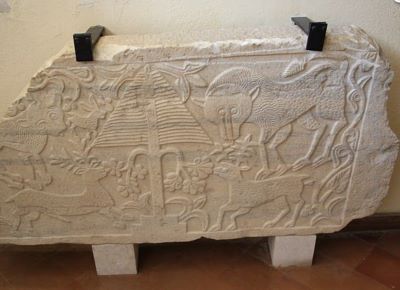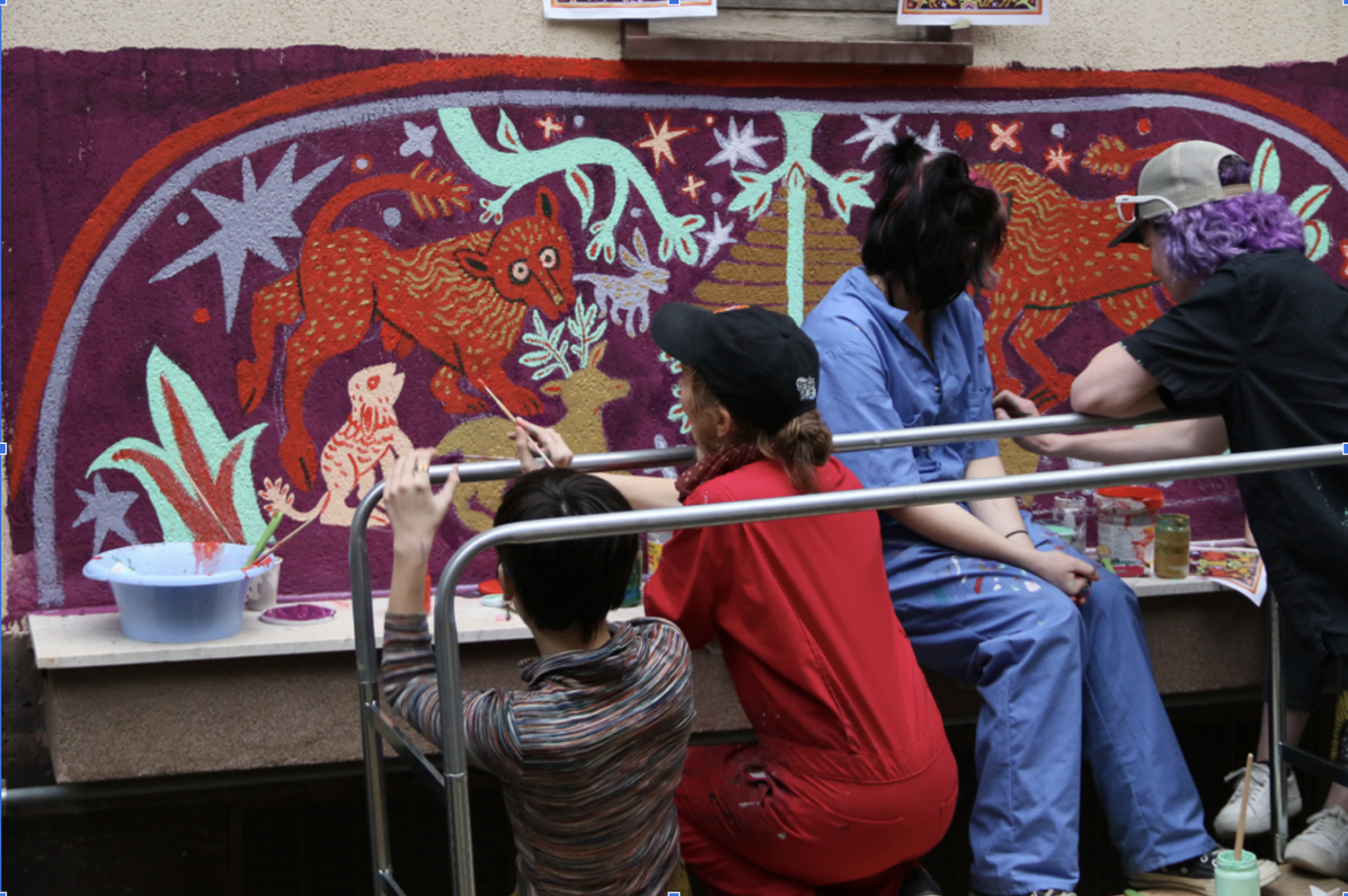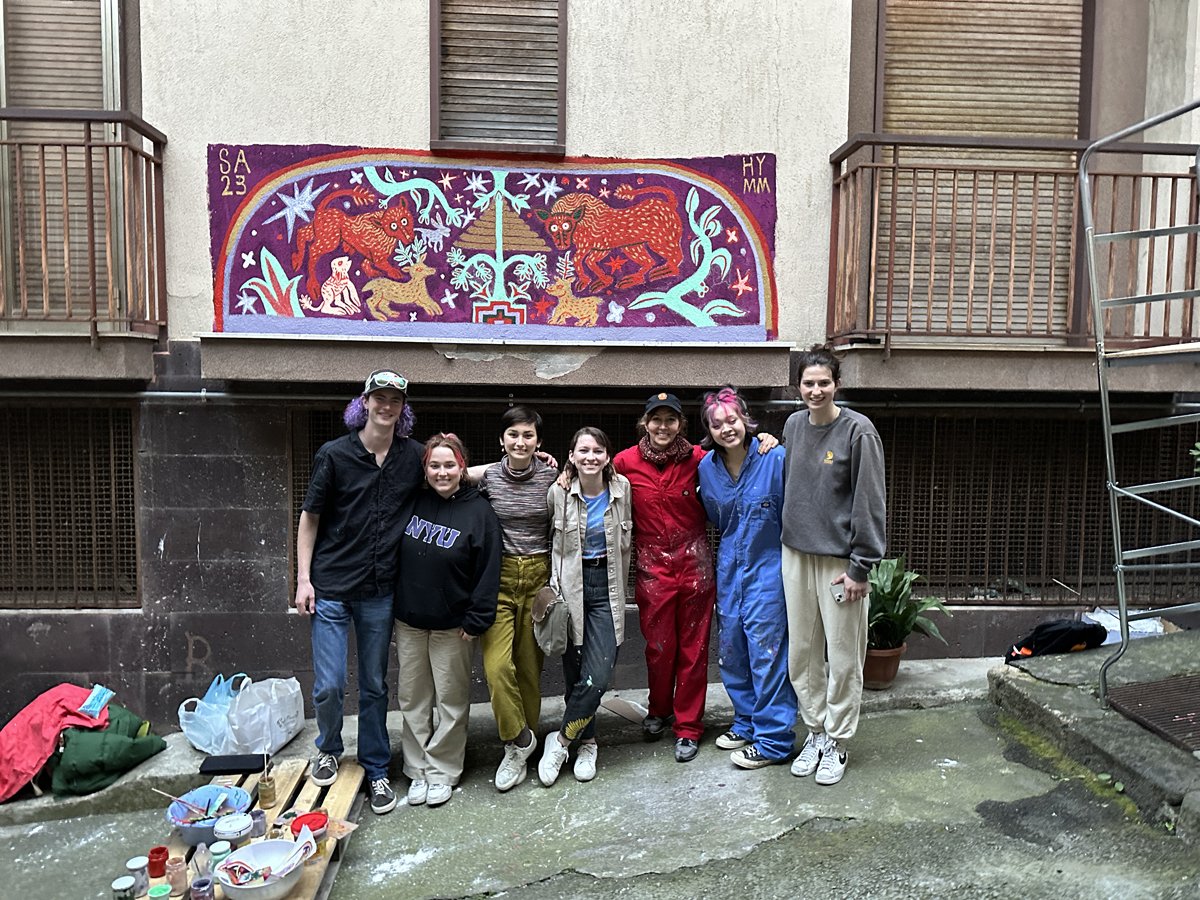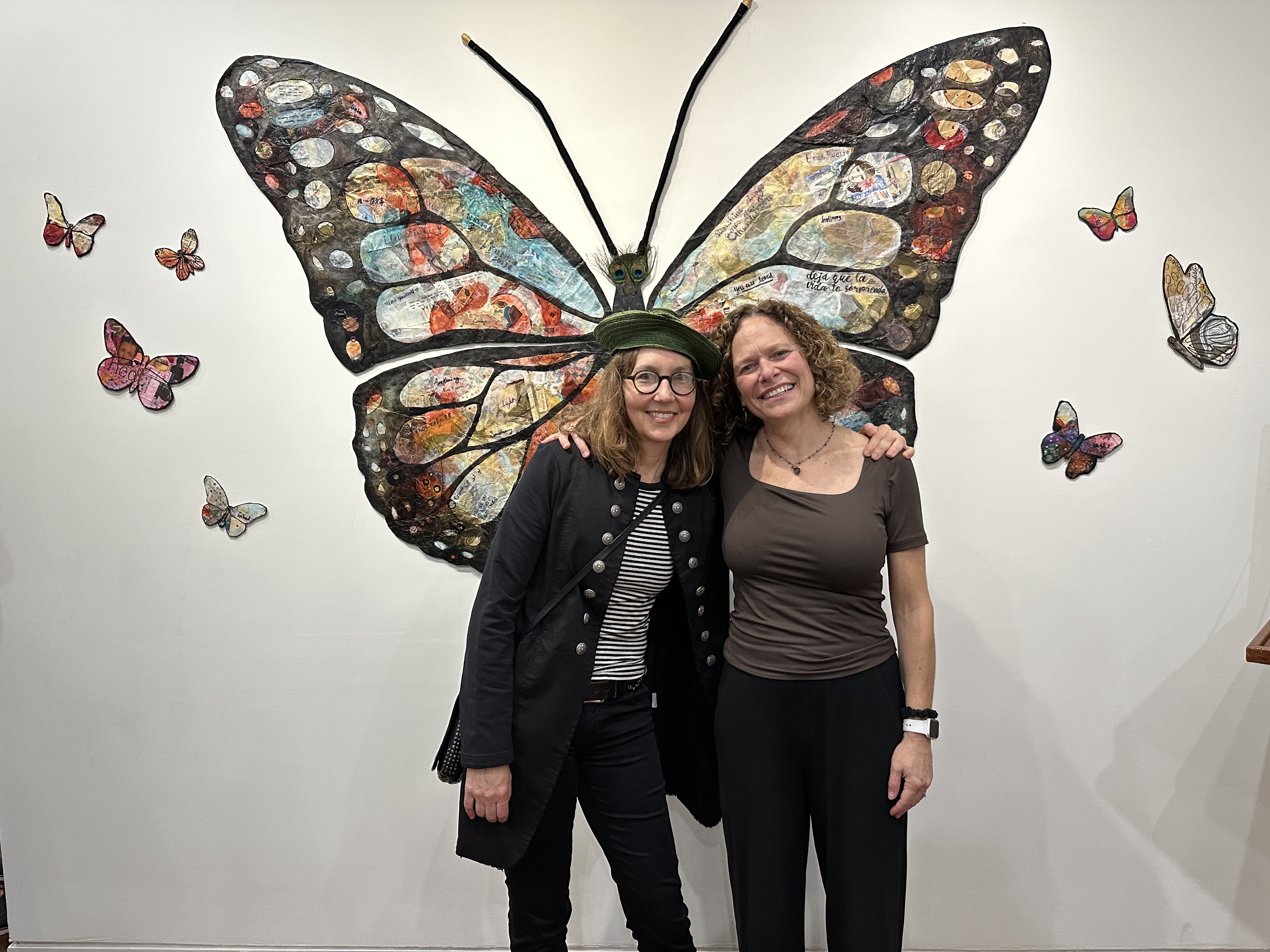The saying that one man's trash is another man's treasure certainly holds true for New York City artist Daniel Lanzilotta. The self-proclaimed plastician prides himself on his non-extractive practices. He rarely invests in supplies; there's enough trash paving the streets, floating in the rivers, and washed up on beaches to work with. By fashioning sculptures and jewelry from this debris, he hopes to inspire more conscientious consumption. As a member of Al Gore's Climate Reality Project and an advisor to The BxArts Factory, Daniel seeks to lead change.
His own inspiration? Daniel points to his Italian heritage and the influence of his family, particularly his grandfather from Barcellona Pozzo di Gotto, Sicily, on his life.
"My grandfather's there; he's in me," Daniel says. "That DNA is very much alive. I carry with me an ancient gene that motivates me and how I see the world."
Daniel shared more about his grandfather, the type of art he creates, the genesis of his journey, how he selects his materials, the story behind his award-winning The Mask, the unique challenges he faces as an environmental artist, his goals, and more.
Tell us about your grandfather who influenced you.
He was a fancy plasterer. He did a lot of beautiful cornice work, all the stuff you would see in the buildings of probably the early twenties, thirties, and forties. And that wore him out. He then became an insurance salesperson. He was the hero of the family because he did very well.
He was very active in the Democratic party, which I find very interesting because Italians are often not. I used to go with him to give out flyers. I remember it might have been for Hubert Humphrey—that's how far back.
My grandfather was a hoot. He never owned a car; he would walk and take the bus everywhere.
He would come every Sunday. They didn't live far away. And he would knock at the door and say, "Guess who?"
He and my grandmother dressed as if they were going to a wedding every single day. I'd say, "Where are you going, Grandpa?" And he'd say, "To get milk," while wearing a three-piece suit, pocket watch, hat, big overcoat, and beautiful, clean, shiny shoes. This was every single day.
He was a very positive, upbeat figure for me. He married outside of his religion, which was the most amazing thing to me. It was the golden standard of marriage for me. They were just the most perfect married couple on the planet. And for him to do that at that time was gigantic. He was the most courageous person I ever knew.
Describe your art.
I work specifically 100% with trash and plastic debris. And that is coming at me at all times, seven days a week, 24 hours a day. I'm wearing it right now. It's my clothes, it's in my body. It's past the blood-brain barrier. It's in the food, it's in Himalayan salt. Microplastics are everywhere.
I gave myself the name plastician to imply that I am working with plastics. I've been doing the plastic thing for 28 or 29 years now, and it has been a very long journey of doing this. And through that journey, I became an environmentalist and an activist. My premise is that I tried to bring significance to the seemingly insignificant, meaning that the bottle cap you see on the street as litter is something way more beautiful than that.
I speak about consumer-extended responsibility and not so much producer-extended responsibility like Coca-Cola or Pepsi, who make the most plastic stuff in the world and have complete disregard for what happens to it. I ask, "How did it get there, and whose responsibility is it?"
As the end user, we are all responsible for ensuring it's put in its proper place because only 9% of plastics get recycled theoretically. So what happens to the other 91%? That goes to landfills, the ocean, and incinerators.
I use beauty through art to capture people's attention and then have a conversation. I'm not the plastic police. In fact, I just got accepted to New York City's Sanitation Trash Academy. I signed a paper for training with the New York City Department of Sanitation. I sent it in thinking I wouldn't hear from them for weeks, and five days later, they said, "You're in." And I said, "Yes, I'm the right guy."
So, it's about awareness and one's personal responsibility to deal with the issues at hand. And they're very detrimental at the moment.
What started your plastician journey?
I was sitting on the beach in France with my son, who was three years old at the time. And he was playing with plastic toys, and I was sitting there looking at plastic debris on the beach. So, I started making assemblies. I was just taking stuff off the beach. I could only use what I found—no screws. I used my Swiss Army knife and started making stuff. I still have all those original pieces, and I would go back by myself and take walks. Then, I kept seeing the same trash over and over and over and over again. And this went on for years, and I just started honing my skills with it.
I am one of the 2024 Human Impacts Institute's Creative Climate Awards recipients for one of my pieces, The Mask. And I have a piece now in TriBeCa. So this art has taken on a life of its own, and I did not ever realize that I would get to this degree, into this depth of it, 29 years ago.
I've been to zillions of conferences about climate change, and they never speak to the art. They're speaking to business, how to create business from a crisis. I have always found that very interesting because you have to deal with crises and change behavior. That's what my real platform is now: behavior modification.
Can you elaborate on how your work brings significance to the seemingly insignificant?
I've attached this concept to the idea of humans. I deal mostly with plastic debris. In the beginning, it was mostly around ocean debris found on beaches. Then, I made the connection between the single-stream use of plastics and human beings and how human beings are treated in society as single-stream use of human beings.
What does that mean? So you're walking down the street, and of course, you see plastic bottles, caps, and other plastic debris constantly coming into the environment. It's mostly, if not all, caused by human beings. It's either carelessly done with the intention of it being thrown out of a window into the environment or placed in overfilled garbage cans.
When I look at trash in the environment, particularly litter, I see displaced energy. That item took an effort and a certain amount of energy to create. If it's a candy wrapper, it was made, printed, transported, and traveled to a store. Then, it was used to protect the product and wound up as litter. So that's displaced energy.
When I look at litter, I'm looking at human trauma: personal trauma. Why would someone do that? How does someone do that? And I equate that with rage, anger, carelessness, and laziness. I see this in many different locales and environments that I go into, and I take trash walks, particularly in New York City and neighborhoods where people don't really care.
When I was growing up in the Bronx, it was very, very clean. Everyone took pride in sweeping, cleaning, hosing sidewalks, trimming hedges, and shoveling snow.
So, making that connection and bringing significance to the seemingly insignificant is essential. I take out of that bottle cap that was displaced and thrown into the environment as litter and create something of beauty from it. Thousands of handmade beads are in my work. I make sculptures, hats, earrings, and all kinds of really incredibly beautiful things from that trash.
I once worked on a crack vial project. Crack cocaine, if you're not familiar with that, comes in very tiny plastic, colorful vials. They're all over the place, so I started collecting them five years ago and made a sculpture. And when I walked into a park up in Harlem, I saw someone keeled over. And I realized that it wasn't a single-stream use of plastic that I was looking at anymore. It was about single-stream human beings and the same attention to litter—or the lack of attention—that is not given to the situation at hand and its impact on our lives. That person who's addicted to hardcore drugs and keeled over or literally overdosing is not cared for either. That person became a single-stream human being. They have a story, and drugs started to play a very pivotal role in their lives, where they're now out on the street. So, I saw the human being becoming that single-stream person who needs to be attended to.
How do you select the plastic debris and other materials you use in your art?
I don't look for stuff, but it finds me. And the times that I do go out for trash walks, I'm looking at content, I'm looking at how people shop, and I'm looking at what's getting thrown out.
Most of the time, I am walking. I have two aspects to it. One aspect is that I look for toys, and I have hundreds and hundreds and hundreds of little human figurines, which I really don't use in the artwork. It's just a comment on society and what I find in the toy world.
The stuff I use as materials in the artwork is just the constant flow of materials. It's never-ending. It's in the streets and the rivers and on the beaches, and it just depends on what catches my eye.
For instance, I made a few pieces from Tropicana orange juice caps, which you constantly see in the environment. On another level, there's the Tropicana orange juice container. They're just very interesting and have beautiful designs, so I use them in my work.
Most of the stuff I find speaks to me in shape, color, and form, such as the type of plastic. And I don't always use it. I hold onto it, and then I make pieces. I use a lot of laundry detergent jugs of different brands. The colors are all very interesting and beautiful.
So the environment is constantly feeding me plastic at some level somehow, somewhere, wherever I go. It doesn't matter what country or what city. It's always in the environment when you least expect it. You think you're in such a clean place, but it's not. It's lurking somewhere. Some interesting shapes will pop up.
Urban centers, of course, are the best places to find the treasures. I don't spend money on art supplies. Over the years, I've concluded that what I do is non-extractive, and one of the key points is that I'm taking trash out of the environment. Plastics. And those materials were extractive materials from their inception. Most of today's plastics are made from crude oil, gas, or coal.
Other artists will use extractive materials like acrylic paints and different art supplies based on fossil fuel consumption. That's extractive art. And so I created this term for myself: I'm a non-extractive artist; I'm only taking out what's already there. Because of that, I've developed many different methods of doing this and processes to make it all stay together.
Tell us the story behind The Mask.
I'm always intrigued by what I find; for instance, the big, black facial part was found on the very eastern part of Canal Street in New York City. And when I found it, it screamed at me. It wanted to be a mask, something I hadn't made in a very long time.
I was reluctant about it, but it was haunting me. At that time, I was being represented by an art gallery in New York, and the curator said, "Make a mask," and so I did.
I wound up putting it in the gallery without him knowing. And when he came in, he was just blown away by that.
It's been a very powerful, powerful mask. It has some kind of energy, and many of these pieces do. I've had people stand in front of these pieces and cry. And I was there.
I was blown away by the fact that these plastic pieces touch people in a way that I never expected. One particular piece in particular is Pointing to Heaven, which is about a little girl who was killed. They have an impact that I wasn't expecting. And the mask is just like that.
It's one of the winners of the Human Impact Institute's Creative Climate Awards for 2024. I was very honored to accept that award. It is made of hundreds and hundreds and thousands of handmade beads that dangle to the floor with a filigree or the floral arrangement of plastic on top of the head of the mask.
The process to get there is really a ritual. The piece is more of a totem that addresses the lack of ritual in our society and the process of healing for personal trauma that a lot of us go through but don't have an outlet to express.
Plastic really is forever. These pieces will outlive many generations, like the ancient arts of the classic periods of Rome, and certainly in the Renaissance, like David and various others, such as Bernini's doors, which use bronze and marble. These ancient materials have lasted for centuries, but plastics will outdo them by far. We're talking thousands of years, and under the right conditions, bronze and marble will disintegrate either by age and atmosphere or acid rain. Plastics may break down, but they're always plastics.
That's what that piece is really about. It's a journey. It took many years to gather the parts. I didn't know it would be the mask, and it all came together.
One day, that mask was fabricated in Bridgeport, Connecticut, and its response has been overwhelming. It's a mesmerizing piece when you're present in front of it; it has a haunting benevolence. It's a cathartic piece again for me, and seeing those who look at it and want to have a conversation about their experience with it has been very rewarding. The face of climate change has been very impactful.
What challenges do you face as an environmental artist?
The pieces that I do stand on their own. But then, when you understand the narrative of the pieces and how they came to be and the story of plastics, fossil fuels, and climate change, you understand that there's a whole other level of connection. And that art is driving the message about personal responsibility for consumption, the responsibilities of corporations, and how we are going to deal with all this in light of the magnitude of what's happening. So that's what an environmental artist is: this converging of activism and a narrative about change. And that's not easy.
When people see this work, they need to know the story. So the story has to go on the side, on the wall, on a pamphlet, or somehow with the talk. And it has to be verbalized and has to be brought to the attention of the viewer.
It's not just a pretty thing that looks nice on the wall. There's a message here to start really reevaluating our participation. We're all in this together. No one is immune. We're all consuming and doing stuff that we probably shouldn't. Some of it is feel-good, and some of it is greenwashing. And so we have to dig a little deeper, make personal changes, and challenge ourselves to start looking at the world because it's a temporary experience. Other people are coming down the pike, and those folks who aren't here quite yet have to come to their senses about what we're leaving behind. And so I asked myself this question: am I finding this place in better condition than when I leave it? Or how will it be when I leave this planet when I die?
My conclusion to my question for myself was, "No, I'm not," even though I try very hard to ensure I'm doing the best I can. I gave up my car well over a year and a half ago, and now I just go by bus, train, and bike. That was my sacrifice; that was offsetting my carbon footprint. And so I do a lot of that. I don't own any fancy computers. I don't have any kind of gigantic electronic equipment. I don't own a TV. I just have my phone. That's a challenge.
What are your future goals and projects?
I got accepted to the New York City Trash Academy with the New York City Department of Sanitation, and that's like a six-week course on everything trash. I am very excited by that, and I hope to gain some really interesting contacts, get involved with the sanitation department, and be able to go and see it. I always fantasize about going back to school and studying trash from an academic point of view.
I would like to get into more galleries as a solo artist. I decided to do a trash chandelier. I've had these pieces for a very long time; they're some kind of plastic armature that I believe thread came on. They're very colorful and beautiful, so finally, I decided, "I have to use these things."
I have about 12 of them, and I'm only using two for the chandelier. Everything has to be from the trash, and it's going to be quite stunning. And I'm very excited by this piece of work that will come of it. It'll take a year or more at the rate I go. And so that's very exciting.
What do you hope viewers take away?
It's about the single-stream use of plastic and bringing significance to the seemingly insignificant, like that bottle cap no one cares about and that person no one cares about. It's also about bringing consciousness to the plastic issue of litter and creating art from it to have a narrative about creating a dialogue.
When people look at my work, they're drawn into it by its beauty, texture, and color. A lot is going on in these pieces. And so they're intrigued by them. I've had many occasions where I've had the opportunity to speak live in a gallery or at an event where I'm asked to speak specifically about what I do. I bring this to their attention: It behooves us as individuals to take responsibility, deal with our trauma, and deal with our unbridled shopping and consumption.
If you enjoyed this article, consider subscribing to my newsletter for more content and updates!





